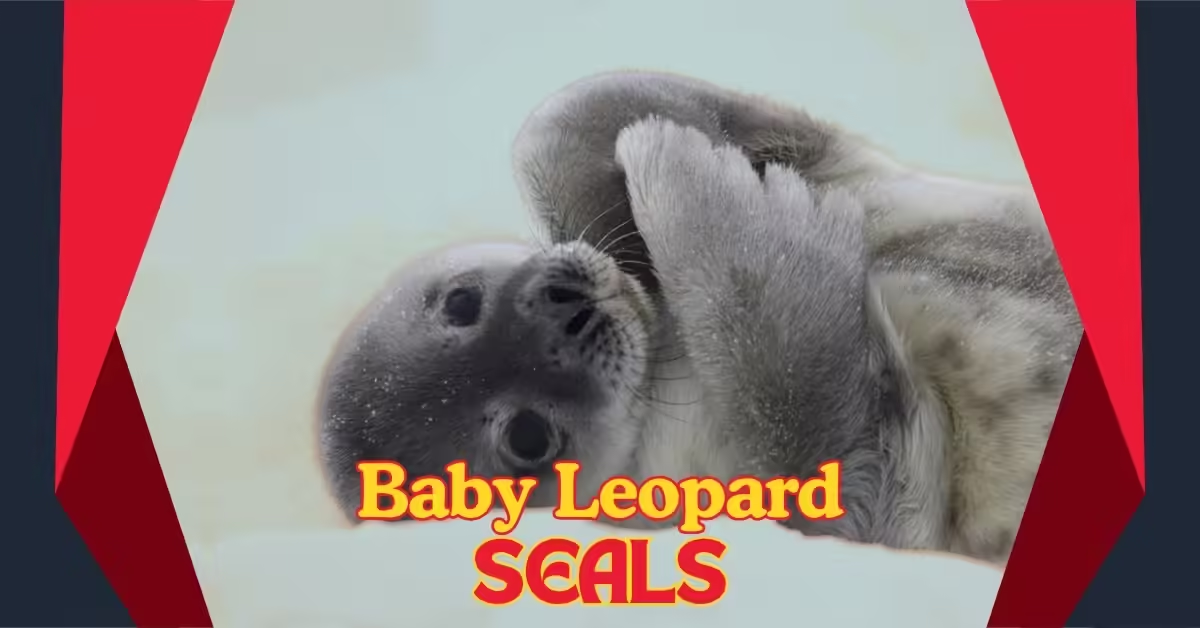The world of the baby leopard seal is as fascinating as it is dangerous. Born into the cold waters of Antarctica, these adorable pups face many challenges, from learning how to hunt to avoiding natural predators. In this blog, we’ll take a deep dive into the early life of a baby leopard seal, covering everything from what they eat to how they survive in one of the harshest environments on Earth. Here are 10 fascinating facts about these incredible creatures that you need to know!
What Is a Baby Leopard Seal? Understanding Leopard Seal Pups
A baby leopard seal, also known as a leopard seal pup, is born on the ice floes of Antarctica. Leopard seals are part of the pinniped family, which includes seals, sea lions, and walruses. At birth, a leopard seal pup typically weighs around 66 pounds (30 kg) and measures about 4 feet long. These pups are born during the Southern Hemisphere’s spring, between November and December, when temperatures in Antarctica are slightly less severe.
Leopard seal pups are known for their beautiful spotted fur, which gives them their distinctive appearance. This patterning helps camouflage them against the icy terrain, offering some protection from predators like orcas and large sharks.
What Do Baby Leopard Seals Eat? A Look at Their Early Diet
What do baby leopard seals eat? Like most newborn mammals, a baby leopard seal is dependent on its mother’s milk for the first few weeks of its life. The mother’s milk is rich in fat, allowing the pup to gain weight quickly and develop the thick layer of blubber it needs to survive in freezing Antarctic waters.
After a few weeks, the mother begins to introduce the pup to solid food. Leopard seals are carnivorous, and once they stop nursing, they rely on a diet rich in krill, squid, fish, and even penguins. While learning to hunt, leopard seal pups often start with smaller prey, gradually working their way up to more challenging catches.
Where Are Baby Leopard Seals Born? Understanding Their Habitat
Leopard seals are unique in that they give birth on Antarctic ice floes, far from human civilization. This isolated and icy environment is the perfect place for leopard seals to rear their young, as it offers them relative safety from predators like killer whales. The mothers will search for thick, stable ice to give birth, providing their pups with a solid, secure place to grow and nurse.
Despite this protection, baby leopard seals are still vulnerable to environmental changes. Melting ice, due to climate change, is shrinking their habitat, which may affect the survival of future generations.
Leopard Seal Pup Behavior: Play, Hunting, and Survival
Baby leopard seals are highly active and curious animals. From a young age, they begin to play and explore their icy surroundings. Playtime is not just for fun—it helps them develop the skills they will need to hunt and survive as adults. Leopard seal pups spend much of their time in the water, learning to swim and practicing their hunting techniques by chasing small fish or even playfully stalking their mothers.
Once they reach about two months of age, they start hunting for themselves, although they still depend on their mothers for food and protection during this critical learning phase.
Growth Stages of a Baby Leopard Seal: From Pup to Predator
The growth stages of a baby leopard seal are marked by rapid development, both physically and behaviorally. Here’s an overview of the key milestones in their growth:
- Newborn (0-4 weeks): At birth, the pup relies solely on its mother’s milk. During this time, it rapidly gains weight and begins developing its blubber.
- Weaning (4-8 weeks): The pup starts to eat solid food, primarily small fish, krill, and squid. The mother teaches it the basics of hunting by demonstrating in the water.
- Juvenile (2-6 months): By this age, the pup is more independent and capable of hunting small prey on its own. It is still growing rapidly and developing the strength needed to catch larger prey like penguins.
- Young Adult (6 months-2 years): As the pup reaches adulthood, it becomes a skilled hunter. Females often stay with their mothers for a bit longer, while males may venture out to establish their own territories.
How Leopard Seals Raise Their Pups: Maternal Instincts in the Wild
Leopard seal mothers are known for their strong maternal instincts. After giving birth, the mother stays close to her pup, nursing and protecting it from any dangers. During the first few weeks of life, the pup remains on the ice floe, learning how to swim and interact with its environment. Mothers are highly attentive and will stay with their pups for up to three months.
Once the pup is ready to fend for itself, the mother leaves, and the pup must rely on the skills it has learned to survive in the harsh Antarctic environment. Unlike some other animals, leopard seal mothers do not form long-term bonds with their offspring after weaning.
Challenges Baby Leopard Seals Face in the Wild
Despite being born in relative safety, baby leopard seals face many challenges in the wild. One of the biggest threats comes from predators such as orcas and large sharks. While the icy habitat offers some protection, leopard seal pups must learn to stay alert and agile to avoid becoming prey.
Another significant challenge is the changing climate. The melting of Antarctic ice due to global warming threatens the very environment in which leopard seals are born and raised. With less ice available, it becomes harder for mothers to find safe places to give birth, and food sources may become scarcer.
How Do Baby Leopard Seals Survive the Cold? Adaptations for Life in Antarctica
Baby leopard seals are born into one of the coldest environments on Earth—Antarctica. To survive these extreme conditions, they have several adaptations that help them stay warm and thrive in icy waters. One of the most important adaptations is the thick layer of blubber that forms shortly after birth. This blubber acts as insulation, helping the pup retain body heat and keep warm in the freezing temperatures.
Additionally, the fur of a baby leopard seal is another crucial feature. While not as thick as their blubber, the fur provides an extra layer of warmth and some camouflage. The spotted pattern helps them blend into the ice and snow, offering a level of protection from predators like orcas. Leopard seal pups also have large, strong flippers that allow them to swim efficiently through the frigid Antarctic waters, which is essential for catching prey and escaping threats.
Another fascinating survival strategy is their ability to hold their breath for extended periods. Even as pups, they can dive and remain submerged for several minutes at a time, allowing them to evade predators or hunt underwater. These physiological adaptations make the baby leopard seal well-equipped to handle life in the cold Antarctic seas.
Leopard Seal Mothers: How Do They Care for Their Pups?
The relationship between a leopard seal mother and her pup is short but intense. Unlike many other animal species, leopard seals don’t form long-term maternal bonds, but during the first few months of a baby leopard seal’s life, the mother is entirely devoted to its care. She nurses her pup with nutrient-rich milk, which helps the pup grow quickly and develop the necessary layers of fat for insulation.
During this period, the mother will also introduce the pup to the water and teach it basic survival skills, like swimming and hunting. While the mother typically stays close to the ice floe, she will occasionally leave her pup alone to hunt for food. This time apart allows the pup to develop independence, a critical skill it will need when the mother eventually leaves for good.
The mother’s care is crucial for the baby leopard seal’s survival. Without her protection and guidance during the early months, a pup would struggle to fend off predators or find enough food to sustain its rapid growth. After a few months, when the pup is strong enough to hunt and survive on its own, the mother leaves, and the pup begins its journey toward adulthood.
For more tips and guides, visit our homepage at My Read Magazine and explore a world of helpful content!
FAQs About Baby Leopard Seals: All Your Questions Answered
1. How long do baby leopard seals stay with their mothers?
Leopard seal pups typically stay with their mothers for about two to three months before becoming independent.
2. What do baby leopard seals eat after weaning?
After weaning, baby leopard seals primarily eat krill, fish, squid, and eventually larger prey like penguins.
3. How fast do leopard seal pups grow?
Leopard seal pups grow rapidly, gaining up to 2-3 pounds per day during their first few weeks of life.
4. Do leopard seal mothers stay with their pups after weaning?
No, once the pup is weaned, the mother leaves, and the pup is left to fend for itself.
5. Where are baby leopard seals born?
Leopard seal pups are born on the ice floes of Antarctica.
6. When do baby leopard seals start hunting?
Baby leopard seals start hunting small prey around two months of age.
7. What are the main predators of baby leopard seals?
The main predators of baby leopard seals are orcas and large sharks.
8. Why do leopard seals leave their pups alone?
Once the pups are weaned and can hunt on their own, the mothers leave to focus on their own survival and reproduction.
9. How does climate change affect baby leopard seals?
Melting ice in Antarctica reduces the amount of stable habitat for leopard seals, making it harder for them to give birth and raise their pups.
10. How long do leopard seals live?
Leopard seals can live up to 26 years in the wild.
Conclusion
The life of a baby leopard seal is filled with both wonder and challenges. From learning to hunt in the icy waters of Antarctica to avoiding predators like orcas, these pups must quickly adapt to survive. Through the care and guidance of their mothers, leopard seal pups grow into one of the most skilled predators in the Antarctic ecosystem. However, their future is uncertain, as climate change continues to threaten the ice habitats they depend on.

Joseph Bush is a seasoned writer and researcher with over 7 years of experience covering a wide range of general topics, from lifestyle and technology to business and current events. He is dedicated to producing fact-checked, reader-friendly content that informs, engages, and empowers readers.
Throughout his career, Joseph has followed strict editorial guidelines, relied on reputable sources, and ensured every article meets the highest standards of accuracy and clarity. His expertise spans multiple fields, allowing him to explain complex topics in a way that’s easy to understand.
Passionate about continuous learning, Joseph stays updated on industry trends and best practices to deliver trustworthy, well-rounded insights. Readers can rely on his work for its credibility, depth, and real-world relevance.




